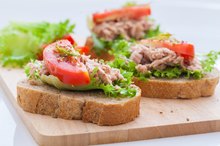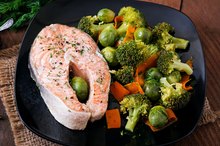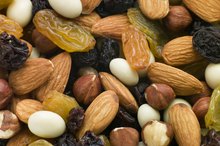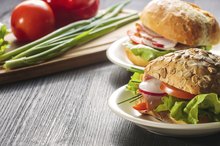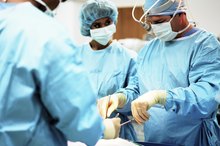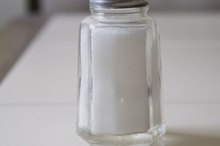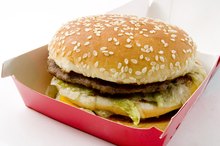What does fact checked mean?
At Healthfully, we strive to deliver objective content that is accurate and up-to-date. Our team periodically reviews articles in order to ensure content quality. The sources cited below consist of evidence from peer-reviewed journals, prominent medical organizations, academic associations, and government data.
- MedlinePlus: Gallbladder Diseases
- Current Treatment Options in Gastroenterology: Biliary and Gallbladder Dyskinesia
- Current Treatment Options in Gastroenterology: Biliary and Gallbladder Dyskinesia
The information contained on this site is for informational purposes only, and should not be used as a substitute for the advice of a professional health care provider. Please check with the appropriate physician regarding health questions and concerns. Although we strive to deliver accurate and up-to-date information, no guarantee to that effect is made.
Gallbladder Dyskinesia Diet
Most people pay little attention to their gallbladder unless it malfunctions. As part of your digestive system, it plays a crucial role in releasing fat-digesting fluid called bile, in response to dietary fat. When your gallbladder fails to eject bile properly, its called gallbladder dyskinesia 3. Because gallbladder problems make it difficult to digest fat, doctors commonly prescribe a fat-restricted diet until the issue is treated or controlled. Follow your physician's dietary instructions and only make changes to your diet under his guidance.
What to Expect
Many gallbladder problems are treated by removing the gallbladder -- a procedure called cholecystectomy. Your doctor will likely refer you for a cholecystectomy if you have gallbladder dyskinesia. About 94 to 98 percent of patients with this condition experience symptom relief after gallbladder removal, according to a review published in the August 2007 edition of the journal "Current Treatment Options in Gastroenterology." You may benefit from staying on a restricted-fat diet before surgery 3. This type of diet typically limits you to 50 grams of fat per day.
- Many gallbladder problems are treated by removing the gallbladder -- a procedure called cholecystectomy.
- Your doctor will likely refer you for a cholecystectomy if you have gallbladder dyskinesia.
Foods to Include
Diet After a Cholecystectomy
Learn More
A restricted-fat diet includes milk, cheese and dairy foods that are fat-free or made from skim milk, as well as lean meat, fish and poultry. Fresh, frozen or canned vegetables and fruits are included also. Other foods typically allowed on this diet are whole-grain breads, rice, pasta, noodles, low-fat whole-grain cereals and low-fat snack options such as:
- unbuttered popcorn
- baked chips
- flavored gelatin
This is by no means a comprehensive list, but provides a general idea of what is usually allowed on a fat-restricted diet used to reduce complications of gallbladder disorders.
Foods to Avoid
Coconuts, avocados and olives are high in fat and on the avoid list. Steer clear of fried or greasy foods in general, including fried potatoes and french fries, as well as fried or fatty meat, fish and luncheon meat. Avoid high-fat breads and pastries, including doughnuts, french toast, waffles and breads made with egg or cheese. Vegetables in cream, cheese, butter or other high-fat sauces are also a red flag. This diet also restricts beverages made from high-fat dairy, high-fat sweets such as ice cream and creamy or oily soups.
- Coconuts, avocados and olives are high in fat and on the avoid list.
- Vegetables in cream, cheese, butter or other high-fat sauces are also a red flag.
Restricted-Fat Diet Tips
Recommended Diet to Deal with Gallstones and Biliary Colic
Learn More
Use low-fat cooking methods such as baking, broiling, roasting or steaming, and trim any visible fat away from meat and poultry before cooking. You may find that eating small frequent meals is better tolerated than consuming three large meals each day. Check food labels when purchasing packaged foods and look for low-fat, nonfat and fat-free options. Create a list of safe foods to take with you grocery shopping, and build your meals around allowed foods.
- Use low-fat cooking methods such as baking, broiling, roasting or steaming, and trim any visible fat away from meat and poultry before cooking.
- Check food labels when purchasing packaged foods and look for low-fat, nonfat and fat-free options.
Related Articles
References
- MedlinePlus: Gallbladder Diseases
- NYU Langone Medical Center: Fat-Restricted Diet
- Current Treatment Options in Gastroenterology: Biliary and Gallbladder Dyskinesia
- Jackson Siegelbaum Gastroenterology: Low Fat Diet
- Cleveland Clinic. Gallbladder and biliary disease. Updated August 2010.
- American College of Surgeons. Cholecystectomy. Updated 2015.
- Cleveland Clinic. Bile duct exploration. Updated August 9, 2019.
- MyHealth.Alberta.ca. Gallstones: Should I have gallbladder surgery? Updated November 7, 2018
- Victoria State Government. Better Health Channel. Gallbladder-gallstones and surgery. Updated August, 2014.
- University of California San Francisco (UCSF). Choledochal cysts. Updated 2020.
- American Cancer Society. Surgery for gallbladder cancer. Updated July 12, 2019.
Writer Bio
Janet Renee is a clinical dietitian with a special interest in weight management, sports dietetics, medical nutrition therapy and diet trends. She earned her Master of Science in nutrition from the University of Chicago and has contributed to health and wellness magazines, including Prevention, Self, Shape and Cooking Light.

